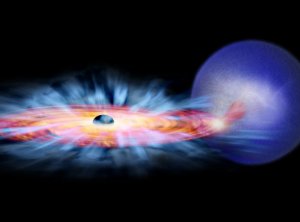Public Outreach
The Public Outreach section of StrongGravity website is here to inform the general public about what this project is about and to explain how European tax money are spent to fund fundamental science. We also want to share our excitement about the most exotic and mysterious objects that can be found in the universe with all the others. After all, we are astronomers and astronomers do like to explain what they have learned by looking into the sky.
StrongGravity is a project that does top-level fundamental science in astrophysics. We focus on processes that take place in a close vicinity of neutron stars and mainly black holes. We have chosen black holes as our target not so much because they are exotic. We have chosen them because they can become the most powerful objects we know of. On the Earth, the most powerful source of energy we have mastered is the atomic bomb. But only less than 0.1% of the total amount of energy that is in the bomb (the rest mass energy) is actually released in its explosion. Black holes are much better, though. They can release up to 40% of the rest mass energy of matter and they can do it so efficiently simply by using their strong gravitation field. This makes them immensely attractive for studying.
 Not every black hole, however, is so energetic. It depends on its size (or mass, to be more precise), rotation and matter supply. The last two ingredient are the most important ones. To release that much energy the black hole has to rotate fast and it needs to have a rich supply of matter from its neighborhood. Usually, the later comes in a form of an accretion disk, which is the key agent in feeding black holes. In fact, accretion disks are the very objects that we are interested in and that we really study. A black hole without its accretion disk is just a dark place in dark and empty space, invisible to an observer. The accretion disk is the thing that makes a black hole shine like a galactic light house.
Not every black hole, however, is so energetic. It depends on its size (or mass, to be more precise), rotation and matter supply. The last two ingredient are the most important ones. To release that much energy the black hole has to rotate fast and it needs to have a rich supply of matter from its neighborhood. Usually, the later comes in a form of an accretion disk, which is the key agent in feeding black holes. In fact, accretion disks are the very objects that we are interested in and that we really study. A black hole without its accretion disk is just a dark place in dark and empty space, invisible to an observer. The accretion disk is the thing that makes a black hole shine like a galactic light house.
In the following series of articles, we explain in more details why we study black holes and accretion disks, how we do that, and what we can learn by that.
OK, it is all about black holes and accretion disks. So let's first have a look on what these objects are:
Chapter 1: What is a black hole?
Chapter 2: What is an accretion disk?
Black hole are found across a large range of masses in the universe, however, the most common classes are stellar black holes and supermassive black holes. There may be also intermediate-mass black holes or speculative microscopic black holes of (relatively) tiny masses out there to fill the gaps, but we are less interested in those in our project. Stellar black holes have masses of the order of tens of solar masses, supermassive black holes weight millions of solar masses or more. Black holes of different classes have different ways of creation and evolution. The supermassive ones have got their masses continuously by merging, the stellar ones only weight as much as a star. How are the different types created and how they evolve? We are going to describe that in the next chapter.
Chapter 3: Creation and evolution of black holes
It is not possible to learn much about a black hole if it does not act on anything. Black holes alone are just black and do not produce any radiation by their own. We can only learn about them by observing how they act on surrounding matter. The closer the particles of matter get to a black hole, the better. We already explained that the tool that delivers particles to the black hole is an accretion disk. In the next chapter, we describe how exactly accretion disks work and how they look like.
Chapter 4: How do accretion disks work?
Astrophysical black holes are expected to have only two characteristics, only two single numbers that characterize them completely and that also characterize the spacetime structure around them (see Chapter 1). These are the mass and the spin (rotation). Let's now have a closer look at whether and how we can measure those black hole characteristics.
Chapter 5: How to measure black hole mass?
Chapter 6: How to measure black hole spin?

